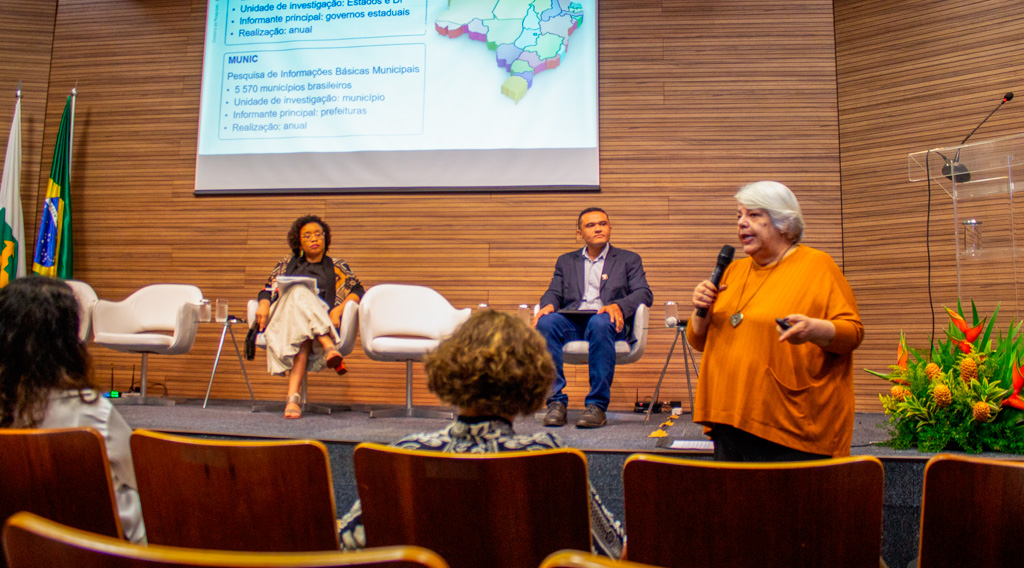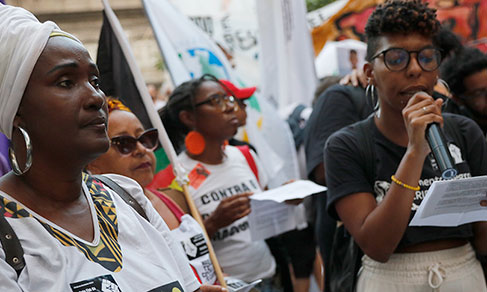Profile of States and Municipalities
Nearly half of municipalities did not have any food and nutritional security management body in 2024
November 07, 2025 10h00 AM | Last Updated: November 07, 2025 03h14 PM
Highlights
- Almost half of the Brazilian municipalities (49%) did not have any organizational structure that dealt with food and nutritional security policy in 2024.
- Women were the majority in the management of the body in the area of food and nutritional security in 2024, but the number drops in more populous municipalities.
- Less than half of the people who headed the food and nutritional security department were of brown, black, Indigenous or Asian color or race; 57.2% of the municipal bodies in the area were managed by white people.
- Most of those in charge of food and nutritional security policy had at least completed higher education.
- More than 60% of the municipalities did not have any food and nutritional security law; the North Region had the lowest proportion of municipalities without the law.
- Ceará, Paraíba and Santa Catarina were the only states that reported the existence of a Food and Nutritional Security Fund in 2024.

Of the 5,544 Brazilian municipalities that responded to the Food and Nutritional Security Supplement of the Survey of Basic Municipal (Munic) and State (Estadic) Information 2024, released today (7) by the IBGE, almost half of them (49% or 2,678) did not have an organizational structure that dealt with food and nutritional security policy last year. On the other hand, the structure was present in all the 26 Federation Units that participated in the survey. Rondônia and 23 municipalities did not respond. Also read the news about actions and equipment related to food and nutritional security in states and municipalities.
Considering the population size of the municipalities, the existence of an organizational structure was lower in the less populated ones. Of the 1,287 municipalities with up to 5,000 inhabitants that responded to this issue, 39.6% (510) had an organizational structure. The proportion increases when the population is larger. Of the 48 municipalities with more than 500,000 inhabitants, 91.7% (44) had an organizational structure. The Northeast was the Major Region with the highest proportion of municipalities with an organizational structure (64.8%), while the Central-West had the lowest one (27.3%).
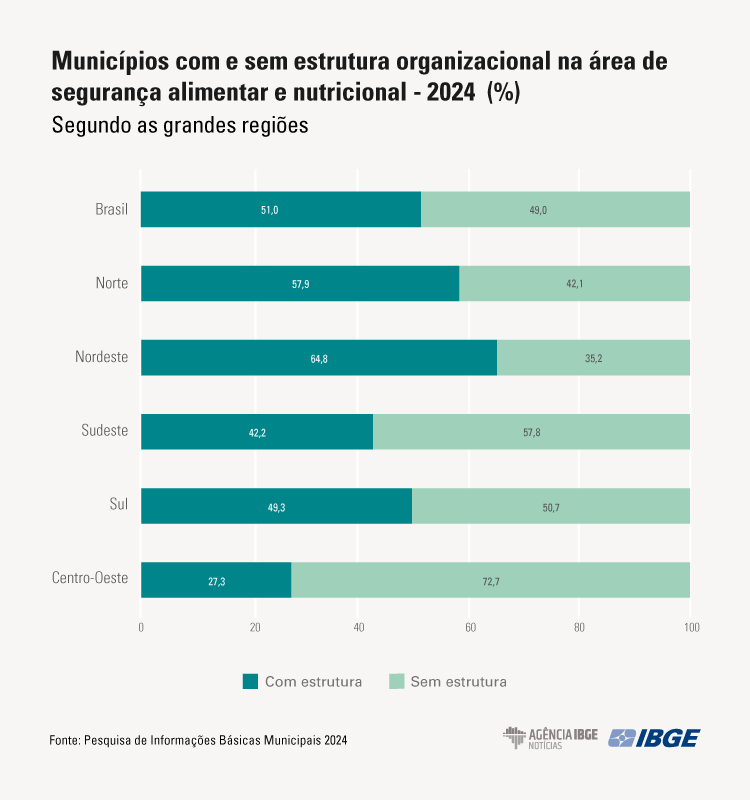
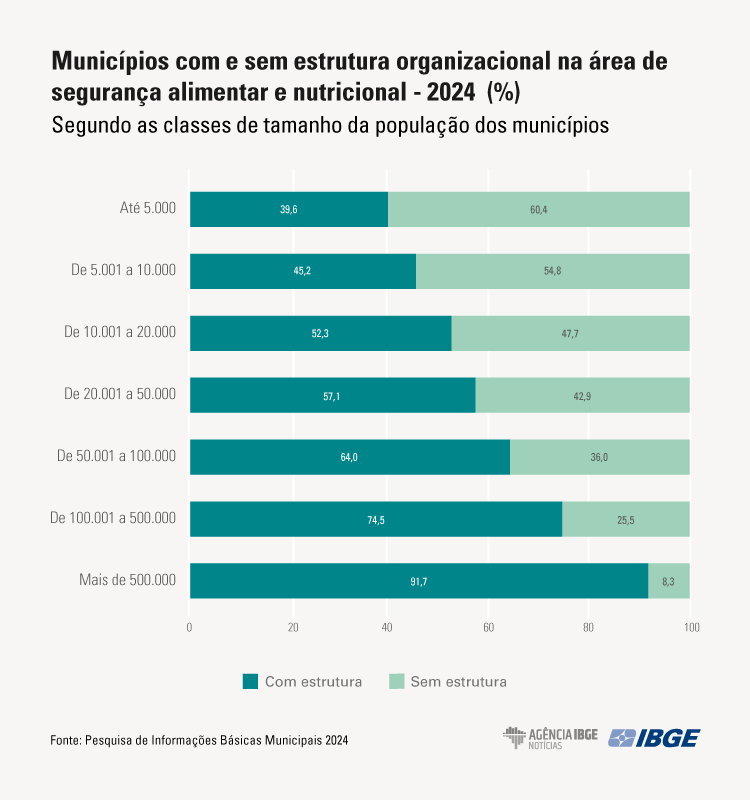
For the manager of Social Studies and Surveys at the Division of Population and Social Indicators, Vânia Maria Pacheco, understanding the fundamental concepts that support the Public Policy on Food Security is essential. “The effective implementation of actions aims to ensure not only the availability of food, but also access and good nutrition of the population. Food and Nutritional Security is a multidimensional concept that encompasses the availability, access and consumption of quality food, which must be reflected in the population's diet, ensuring that everyone has the right to enjoy food in adequate quantity and quality,” highlighted Pacheco.
Women are the majority in management, but the number drops in more populous municipalities
Women were the majority in charge of the management body in the area of food and nutritional security in 2024. In the 26 Federation Units surveyed, there were 16 female managers. Among the 2,820 municipalities that responded about the information, 69.6% (1,963) had women heading the management body, while men were 30.4% (857). The proportion of women decreases with the increase in the population of the municipalities. In the 510 municipalities with up to 5,000 inhabitants with a structure, 75.3% (384) had women commanding the organizational structure of food and nutritional security policy, while men were 24.5% (125). In municipalities with more than 500,000 inhabitants (44), women were in charge of the body in 52.3% (23), while men were 47.7% (21).
Less than half of the people who command the department are of brown, black, Indigenous or Asian color or race
Of those in charge of the organizational structure of food and nutritional security policy in the Federation Units, the majority were people of white color or race, 61.5% (16) in 2024. Those of brown color or race were 23.1% (6), and black, 15.4% (4). No Indigenous or Asian person headed any state or district department.
In relation to the municipalities, most managers were also of white color or race, 57.2% (1,616). People of brown color or race were 35.2% (996), and black, 6.6% (186). With smaller representations, people of Asian color or race were 0.5% (15), and Indigenous people, 0.2% (6).
Among the Major Regions, the North and Northeast were those with the highest proportions of non-white people managing municipal departments in 2024. The predominance in both regions was of brown people, 64.2% (165) and 47.8% (552), respectively. In the North, people of black color or race were 7.4% (19); Indigenous, 1.9% (5); and Asian, 0.8% (2). In the Northeast, black, 9.1% (105); Indigenous, 0.1% (1); and Asian, 0.1% (1).
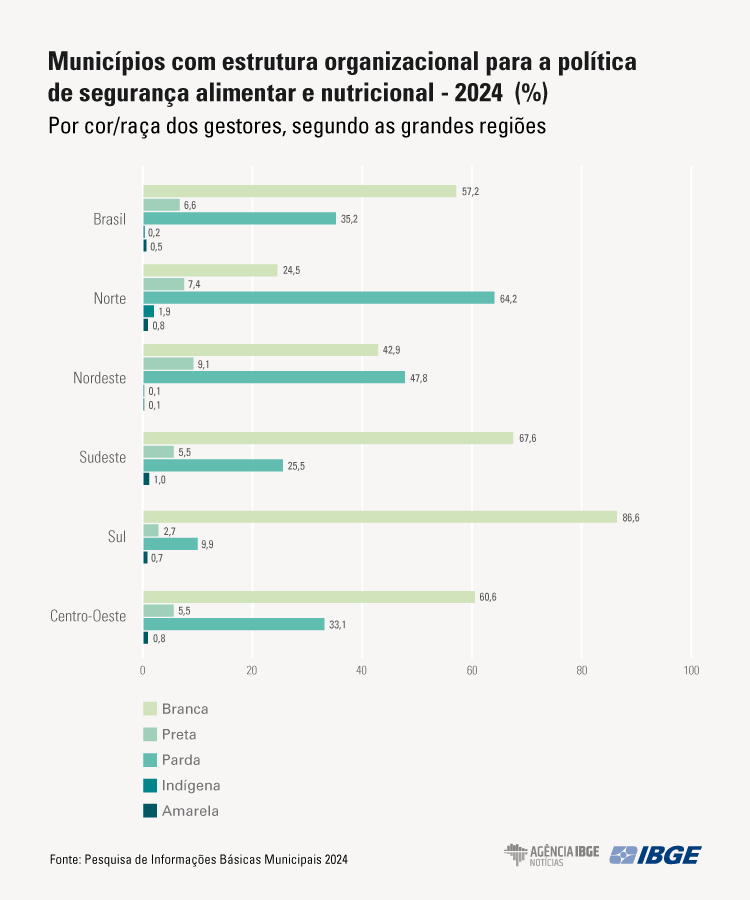
For the survey´s analyst Vânia Maria Pacheco, public policies can be impacted by the lack of diversity. “Brazil has diverse ethnicities and cultures, and public entities must reflect this. The lack of groups such as black, brown and Indigenous people in leadership positions can result in ineffective policies. The formulation of food and nutritional security policies should not occur in a generic manner, since the different characteristics of ethnic groups — relating to food culture, the organization of food production and marketing processes, as well as social relations — constitute conditioning elements in the availability, access and appropriation of food,” explained her.
Most of those who are at the forefront of food and nutritional security policies have at least completed higher education
Regarding schooling level, six managers in the Federation Units had a master's degree; eight, specialization; 11 completed higher education; and one completed secondary education.
Regarding the schooling level of those who were in charge of the department in the municipalities and answered the question, 28.1% (791) had a postgraduate degree; 51.6% (1,454) completed higher education; 11.0% (311) completed secondary education; 0.9% (26) completed primary education; and 0.8% (22) did not complete primary education.
Regarding the population size of the municipalities, the highest proportion of managers who had completed higher education and/or postgraduate studies were in places between 100,000 and 500,000 inhabitants, 89.2%. In the Major Regions, the Central-West and Southeast had the highest proportions of managers with this level of education, respectively 85.0% and 82.9%. They are followed by the Northeast, with 79.9%, and North, with 78.0%. The South was the region with the lowest proportion of managers with complete higher education and/or postgraduate studies, 76.7%.
More than 60% of the municipalities did not have a food and nutritional security law
The states of Rio Grande do Norte and São Paulo reported that they did not have a state law on food and nutritional security in 2024. As for Espírito Santo, the law was in progress. In 2023, in addition to these, Acre also did not have a state law. In 2018, Alagoas and Mato Grosso were added to those mentioned above.
Among the municipalities, 62.8% (3,478) reported that they did not have a municipal food and nutritional security law in 2024. The proportion decreased compared to previous years: in 2023, it was 65.2% (3,631); and, in 2018, 78.2% (4,356).
Regarding the size of the population, the more populous the municipality, the lower the proportion of those that do not have this legislation. In municipalities with up to 5,000 inhabitants, 73.5% did not have a food and nutritional security law. In municipalities with more than 500,000 inhabitants, the proportion fell to 16.7%.
Less than 10% of the municipalities have a Food and Nutritional Security Plan
The Munic Estadic 2024 Food and Nutritional Security supplement also evaluated the Food and Nutritional Security Plan, a tool for planning, implementing and evaluating state and municipal public policies to promote adequate and healthy eating and combat food insecurity.
State Food and Nutrition Security Plans were available in 17 Federation Units, and, in all of them, the plan was approved by the State Food and Nutrition Security Council: Acre, Amazonas, Pará, Maranhão, Ceará, Paraíba, Pernambuco, Bahia, Minas Gerais, Espírito Santo, Rio de Janeiro, São Paulo, Paraná, Rio Grande do Sul, Mato Grosso do Sul, Mato Grosso and the Federal District. The number of states was smaller than in 2023, which also included Amapá, Tocantins, Rio Grande do Norte and Santa Catarina.
In relation to municipalities, it was no different and there was a decrease. While in 2023, 18.8% (1,048) had a Municipal Food and Nutrition Security Plan, and, in 2024, the proportion fell to 7.1% (394). Most municipalities claimed that the information provided in 2023 was incorrect.
Only three states have a Food and Nutritional Security Fund
Public funds constitute financial management instruments that allow resources to be linked to specific purposes, providing greater stability and predictability in the financing of certain public policies. They are characterized by a specific allocation and differentiated management in relation to ordinary treasury resources.
Only three states reported the existence of a State Food Security Fund: Ceará, Paraíba and Santa Catarina. In all three, the fund's management council is the State Council for Food and Nutritional Security. As for the resources, in Ceará and Santa Catarina, the origin was the state itself, in Paraíba, the state itself and the Union.
Among the 23 Federation Units that did not have a fund, almost all resources originated, in whole or in part, from the state. The exception was Amazonas, where the origin of the resources was the Union. Pará, Piauí, Minas Gerais and Rio Grande do Sul reported that part of the resources for the food and nutritional security policy came from national entities/organizations. No Federation Unit reported receiving resources for the policy from international entities/organizations.
In relation to the municipalities, out of a total of 5,542, 2.8% (155) had a Municipal Food and Nutritional Security Fund. The Southeast Region and Minas Gerais had the highest proportion of municipalities within their scope in this condition, respectively, 4.3% (72) and 6.0% (26). No municipality in Acre, Amazonas, Roraima, Amapá and Rio de Janeiro reported the existence of the fund.
The 2,785 municipalities that did not have funds reported that the origin of the resources for the food and nutritional security policy came from at least one of the sources investigated: in 87.2% (2,432) they were their own resources; 39.0% (1,085) from the state, 38.7% (1,079) from the Union; and, 1.0% (29) and 0.2% (6), respectively, resources from national and international entities\/organizations.
About the survey
The Food and Nutritional Security supplement of the Survey of Basic Municipal (Munic) and State (Estadic) Information 2024 provides information on the management of the public food and nutritional security policy, with data on legislation, management and participation instruments, food and nutritional security actions and equipment in states and municipalities.









